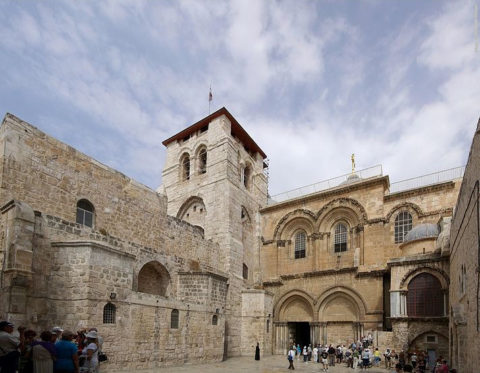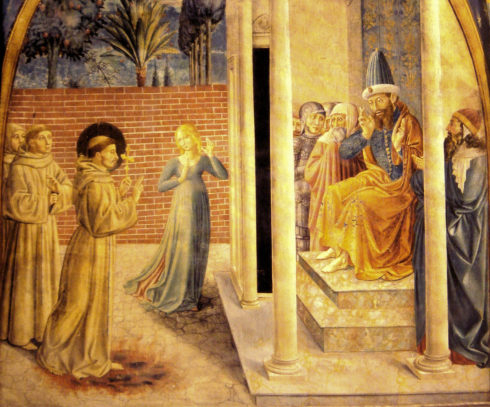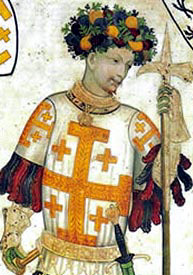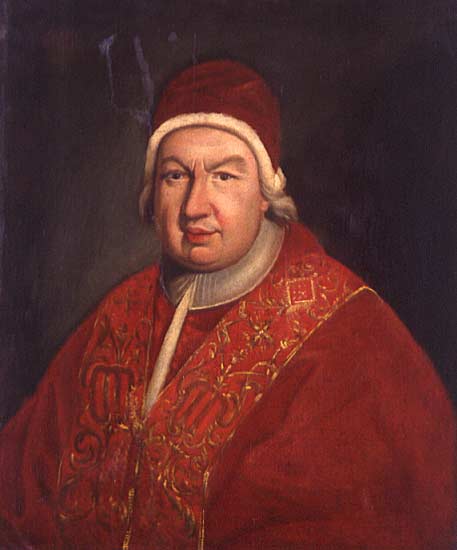Pope Pius III & A Day That Sparked The Crusades
B. at Siena, 29 May, 1439; elected 22 Sept., 1503; d. in Rome, 18
Oct., 1503, after a pontificate of four weeks. Piccolomini was the son
of a sister of Pius II. He had passed his boyhood in destitute
circumstances when his uncle took him into his household, bestowed upon
him his family name and arms, and superintended his training and
education.
He studied law in Perugia and immediately after receiving the
doctorate as canonist was appointed by his uncle Archbishop of Siena,
and on 5 March, 1460, cardinal-deacon with the title of S. Eustachio.
The following month he was sent as legate to the March of Ancona, with
the experienced Bishop of Marsico as his counsellor. “The only thing
objectionable about him”, says Voigt (Enea Silvio, III, 531), “was his
youth; for in the administration of his legation and in his later
conduct at the curia he proved to be a man of spotless character and
many-sided capacity.” He was sent by Paul II as legate to Germany, where
he acquitted himself with eminent success, the knowledge of German that
he had acquired in his uncle’s house being of great advantage to him.
During the worldly reigns of Sixtus IV and Alexander VI he kept away
from Rome as much as possible. Sigismondo de Conti, who knew him well
tells us that “he left no moment unoccupied; his time for study was
before daybreak; he spent his mornings in prayer and his midday hours in
giving audiences, to which the humblest had easy access. He was so
temperate in food and drink that he only allowed himself an evening meal
every other day.” Yet this is the excellent man to whom Gregorovius in
his “Lucrezia Borgia”, without a shadow of authority, gives a dozen
children-the calumny being repeated by Brosch and Creighton. After the
death of Alexander VI, the conclave could not unite on the principal
candidates, d’Amboise, Rovere, and Sforza; hence the great majority cast
their votes for Piccolomini, who though only sixty-four was, like his
uncle, tortured with gout and was prematurely old. He took the name of
Pius III in honour of his uncle, was crowned on 8 Oct., after receiving
priestly and episcopal orders. The strain of the long ceremony was so
great that the pope sank under it. He was buried in St. Peter’s, but his
remains were later transferred to S. Andrea della Valle where he rests
by the side of Pius II.
PASTOR, History of the Popes, VI, 185 sqq.; PANVINIO, Continuation of Platina; VON REUMONT, Gesch. der Stadt Rom; ARTAND DE MONTOR, History of the Popes (New York, 1867).
JAMES F. LOUGHLIN (Catholic Encyclopedia)
October 18 – A day that sparked the Crusades
Destruction of the Church of the Holy Sepulchre
On October 18, 1009, under Fatimid caliph Al-Hakim bi-Amr Allah,
orders for the complete destruction of the Church of the Holy Sepulchre,
also called the Church of the Resurrection, were carried out. The
measures against the church were part of a more general campaign against
Christian places of worship in Palestine and Egypt, which involved a
great deal of other damage. Adhemar of Chabannes recorded that the
church of St George at Lydda “with many other churches of the saints’
had been attacked, and the ‘basilica of the Lord’s Sepulchre destroyed
down to the ground’”.
European reaction was of shock and dismay, with far-reaching and
intense consequences. Ultimately, this destruction provided an impetus
to the later Crusades.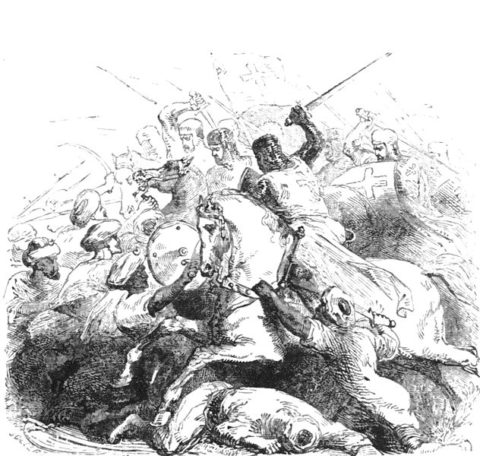
It was for the deliverance of the Holy Sepulchre that the crusades were organized; it was for its defence that military orders were instituted. During the Middle Ages this memorable relic of Christ’s life on earth was looked upon as the mystical sovereign of the new Latin state. Godfrey of Bouillon desired no other title than that of Defender of the Holy Sepulchre, and different Latin princes, Bohemond of Antioch, and Tancred, acknowledged themselves its vassals.
Knights of the Holy Sepulchre
Neither the name of a founder nor a date of foundation can be assigned to the so-called Order of the Holy Sepulchre if we reject the legendary traditions which trace its origin back to the time of Godfrey of Bouillon, or Charlemagne, or indeed even to the days of St. James the Apostle, first Bishop of Jerusalem. It is in reality a secular confraternity which gradually grew up around the most august of the Holy Places.It was natural that the Holy Sepulchre also had its special knights. In the broad acceptation of the word, every crusader who had taken the sword in its defense might assume the title from the very moment of being dubbed a knight. Those who were not knighted had the ambition of being decorated knights, preferably in this sanctuary, and of being thus enabled to style themselves Knights of the Holy Sepulchre par excellence. The fall of the Kingdom of Jerusalem did not suspend pilgrimages to the Tomb of Christ, or the custom of receiving knighthood there, and, when the custody of the Holy Land was entrusted to the Franciscans, they continued this pious custom and gave the order its first grand masters.
The
official arrival of the Friars Minor in Syria dates from the Bull
addressed by Pope Gregory IX to the clergy of Palestine in 1230,
charging them to welcome the Friars Minor, and to allow them to preach
to the faithful and hold oratories and cemeteries of their own. Thanks
to the ten years’ truce concluded during the preceding year between
Frederick II of Sicily and the sultan, the Franciscans were enabled to
enter Jerusalem, but they were also the first victims of the violent
invasion of the Khorasmians in 1244, thus opening the long Franciscan
martyrology of the Holy Land. Nevertheless, the Franciscan province of
Syria continued to exist with Acco as its seat. The monks quickly
resumed possession of their convent of Mount Sion at Jerusalem, to which
they have demonstrated their claim with the blood of their martyrs and
where they have obstinately retained their foothold in spite of
numberless molestations and outrages for five hundred years.
The Turks, notwithstanding their fierce fanaticism, tolerated the
veneration paid to the Tomb of Christ, because of the revenue they
derived from the taxes levied upon pilgrims. In 1342, in his Bull
“Gratiam agimus”, Pope Clement VI officially committed the care of the
Holy Land to the Franciscans, who fulfilled this trust until the
restoration of the Latin Patriarchate of Jerusalem by Pius IX.
Consequently, after 1342, to be enrolled among the Knights of the Holy
Sepulchre, it was necessary to apply to the Franciscans, and from this
period the itineraries of pilgrims mention frequent receptions into this
confraternity – improperly called an order, since it had no monastic
rule, regular organization, or community of goods. Where mention is made
of the possessions of the Holy Sepulchre, the allusion is to the Canons
of the Holy Sepulchre, who had convents in various lands, and not to
the knights, as some writers believe.
Pilgrims were received into this lay confraternity with all the
external ceremonial of ancient chivalry, although the fundamental rules
of the institution were not always observed. It was objected that many
on whom knighthood was conferred were not of the nobility. The formal
question, “if he were of noble birth”, was always put to the applicant,
but in event of his being a merchant or a plebeian he was not obliged to
answer. In point of fact all classes were represented in these
pilgrimages, and it is easy to understand why those who had accomplished
this trying devotion, then so fraught with danger, should desire to
carry away from Jerusalem some such lasting souvenir as the insignia of
knighthood, and that refusal was difficult, especially since the
sanctuary was practically dependent on the offerings of these merchants,
and consequently these contributions were far more deserving of
recognition than the platonic vow to exert oneself as far as possible in
the defense of the Holy Land. In the ceremonial of reception, the rôle
of the clergy was limited to the benedictio militis, the final act of dubbing with the sword being reserved to a professional knight.
It has been ascertained that, in the fifteenth century from 1480 to
1495, there was in Jerusalem a German, John of Prussia, who acted as
steward for the convent and who, in his character of gentleman and
layman, regularly discharged this act reserved to knighthood. It was
also of frequent occurrence that a foreign knight, present among the
crowds of pilgrims, would assist at this ceremony. However, in default
of other assistance, it was the superior who had to act instead of a
knight, although such a course was esteemed irregular, since the
carrying of the sword was incompatible with the sacerdotal character. It
was since then also that the superior of the convent assumed the title
of grand master, a title which has been acknowledged by various
pontifical diplomas, and finally by a Bull of Benedict XIV dated 1746.
When Pius IX re-established the Latin Patriarchate of Jerusalem in
1847, he transferred to it the office of grand master of the order. At
the same time he drew up and in 1868 published the new statutes of the
order, which created the three ranks – that of the grand cross, that of
commander, and that of simple knight – ordained that the costume be a
“white cloak with the cross of Jerusalem in red enamel”, and regulated
the chancellor’s fees. By his Bull of 30 May, 1907, Pius X effected the
latest change by reserving to himself the grand-mastership of the order,
but delegating his powers to the present Latin patriarch.
QUARESMIUS, Historica Terrœ Sanctœ elucidatio (Antwerp, 1639); HODY, Notice sur les chevaliers du St-Sépulcre (Académie d’archéologie, Antwerp, 1855); HERMENS, Der Orden vom h. Grabe (Cologne, 1870); COURET, L’Ordre du St-Sépulcre de Jerusalem (Paris, 1905).
(cfr. Catholic Encyclopedia)
_________________
Also of interest:

